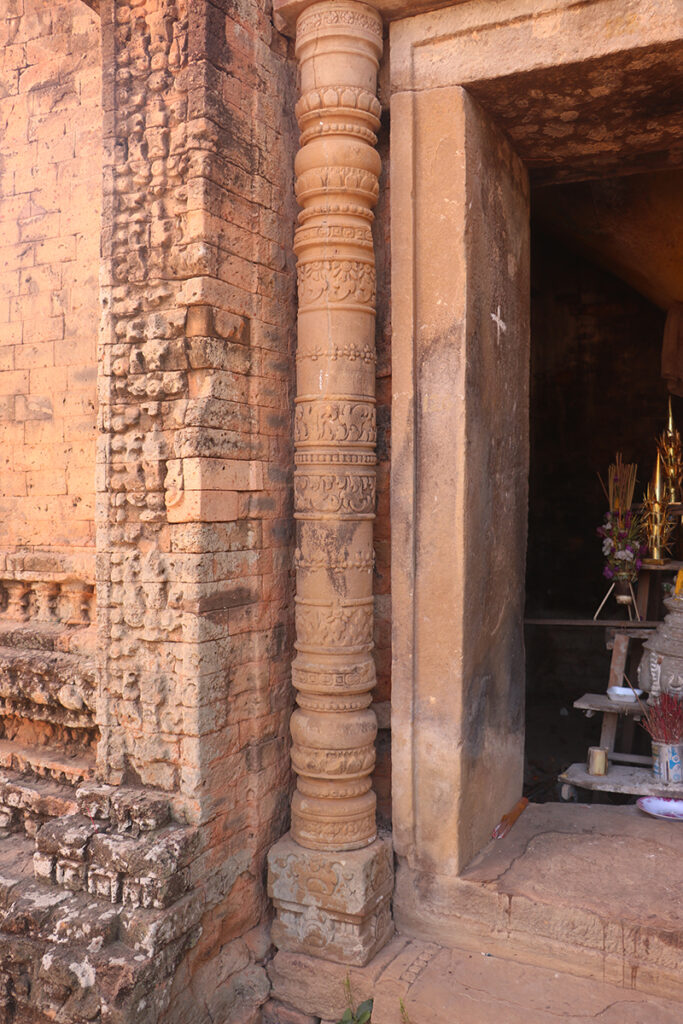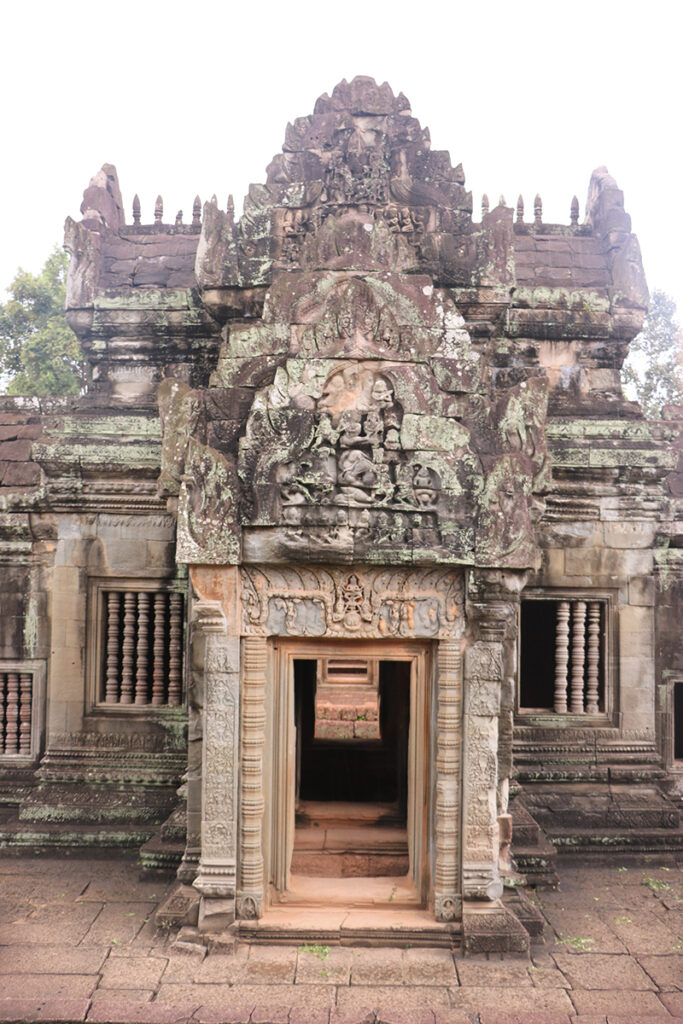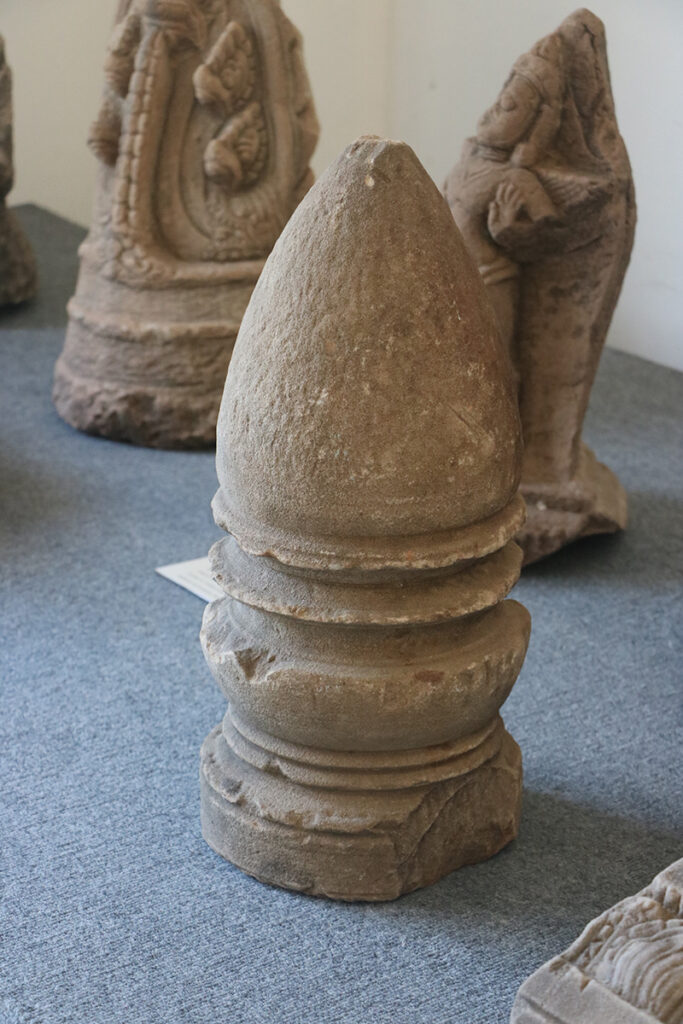នៅភាគទី១នៃប្រធានបទនេះ មានការបង្ហាញពីអត្ថន័យនិងសេចក្ដីសំខាន់មួយចំនួនតាមបែបបដិមាសាស្ត្ររបស់កលឝជាហូរហែរួចមកហើយ។ សម្រាប់ភាគទី២នេះ យើងនឹងមកពិនិត្យលើការយកកលឝមកបញ្ចូលទៅក្នុងស្ថាបត្យកម្មខ្មែរនៅសម័យបុរាណបន្ថែមទៀត។ ចំពោះស្ថាបត្យកម្មខ្មៃរសម័យបុរាណមានការលម្អដោយកលឝ និងចម្លាក់រូបកលឝនៅច្រើងកន្លែងណាស់ ពោលគឺមានតាំងពីផ្នែកខឿននៃប្រាសាទរហូតដល់ផ្នែកកំពូលនៃប្រាសាទ។ ជាក់ស្ដែងនៅតាមខឿននៃប្រាសាទមួយចំនួននៅមុនសម័យអង្គរ មានការលម្អតួខឿងជាក្បាច់ពេជ្រមូល តែបើសង្កេតឱ្យល្អិតបន្តិច ដោយមើលបន្ថែមជាមួយតួខឿននិងក្បាច់ឈូកផ្ងារខាងលើយើងនឹងឃើញថា ខឿនទាំងមូលនោះមានសណ្ឋានស្រដៀងគ្នាទៅនឹងរូបកលឝទៅវិញ។ ចំណុចនេះត្រូវគ្នាយ៉ាងខ្លាំងទៅនឹងលក្ខណៈខឿនមួយប្រភេទនៅក្នុងសិល្បៈឥណ្ឌា ដែលគេស្គាល់ជាភាសាសំស្ក្រឹតថា “កលឝ Kalaśa” ឬ “កុមុទ Kumuda” ឬ “វល័យ Valaya”។

ផ្នែកសំខាន់មួយទៀតនៃស្ថាបត្យកម្មខ្មែរដែលនិយមលម្អរូបកលឝគឺ នៅតាមសសរពេជ្រដែលអមមាត់ទ្វារចូលនៃប្រាសាទខ្មែរ។ ករណីនេះយើងអាចសង្កេតឃើញយ៉ាងច្បាស់នៅតាមបណ្ដាសសរពេជ្រនៅមុនសម័យអង្គរ និងដើមសម័យអង្គរ ដោយច្រើនតែលម្អនៅផ្នែកខាងចុងនិងគល់នៃសសរពេជ្រជារូបកកលឝ។ រូបកលឝទាំងនោះនឹងបាត់រូបរាងបន្តិចៗពីលើសសរពេជ្រចាប់ពីពាក់កណ្ដាលសម័យអង្គរទៅ។ ក្រៅពីនៅតាមច្រកចូលប្រាសាទហើយ យើងអាចប្រទះឃើញការលម្អកលឝនៅតាមផ្នែកដំបូលនៃប្រាសាទមួយចំនួនផងដែរ ហើយឧទាហរណ៍មួយដែលយើងអាចឃើញដោយច្បាស់គឺកលឝនៅកំពូលប្រាសាទបន្ទាយស្រីជាដើម។ រូបរាងរបស់កលឝនៅតាមកំពូលប្រាសាទនឹងមានការវិវត្តបន្តិចម្ដងៗពីរាងមូលទៅជាក្លែបៗ សណ្ឋានដូចផ្លែល្ពៅ និងមានការលម្អក្បាច់ត្របកឈូកនៅលើក្លែបនីមួយៗផងដែរ។


ករណីចម្លាក់មួយប្រភេទទៀតដែលមានសណ្ឋានជាកលឝ ហើយគេនិយមយកទៅលម្អនៅតាមព្រំដំបូលនៃសំណងគឺ នាងច្រាល។ នាងច្រាលជាផ្នែកមួយនៃការលម្អសំណង់បុរាណខ្មែរ មានសណ្ឋានជាបង្គោលខ្លីៗ ផ្នែកខាងក្រោមមានរាងប៉ោងដូចក្អមឬឆ្នាំង ទ្រផ្នែកខាងលើមានរាងជាផ្កាឈូកក្រពុំ។ បើយើងពិចារណារូបរាងរបស់នាងច្រាលដែលមានផ្នែកខាងក្រោមជាភាជន៍សណ្ឋានដូចក្អមឬឆ្នាំ ហើយផ្នែកខាងលើមានផ្កាផុសចេញមកនោះឃើញថា គំនិតនេះមានលក្ខណៈស្រដៀងគ្នាយ៉ាងខ្លាំងទៅនឹងបូរណកលឝ (Pūrṇa Kalaśa) ឬបូរណកុម្ភ (Pūrṇa Kumbha) ឬបូរណឃាត (Pūrṇa Ghạta)ដែលជានិមិត្តរូបមង្គលនៃសិល្បៈឥណ្ឌា។ គេច្រើនប្រដាប់នាងច្រាលនៅតាមព្រំដំបូលនៃរោងទង ខ្លោងទ្វារប្រាសាទ ព្រំដំបូលនៃយ៉ប្រាសាទ ទ្រនុងកំពែងប្រាសាទ ឬបណ្ណាល័យប្រាសាទជាដើម។


ក្រៅពីនេះយើងសង្កេតឃើងញមានការលម្អរូបបូរណកលឝនៅតាមហោជាងនិងសំណង់ស្ថាបត្យកម្មមួយចំនួនផងដែរ ជាក់ស្ដែងនៅហោជាងប្រាសាទក្រចាប់មានលម្អរូបបូរណកលឝចំនួន២នៅអមសងខាងព្រះវារុណ។ រូបបូរណកលឝនោះមានរូបរាង ជាឆ្នាំងឬក្អមដែលមានរុក្ខជាដុះចេញមកតាមមាត់ឆ្នាំងឬក្អមនោះ។ ចម្លាក់ប្រហែលគ្នានេះក៏ប្រទះឃើញមាននៅតាមកំពូលនៃបង្គោលពុទ្ធាសាសនាមហាយាន និងកំពូលចេតិយមួយចំនួននៅក្នុងសម័យអង្គរនិងចុងសម័យអង្គរផងដែរ។

ជាសរុបមកការប្រើប្រាស់រូបកលឝសម្រាប់ការលម្អនៅក្នុងស្ថាបត្យកម្មខ្មែរមានការនិយមរាប់អានយ៉ាងខ្លាំង ព្រោះកលឝជានិមិត្តរូបនៃមង្គល តំណាងឱ្យភាពសម្បូរសប្បាយ ភោគផល កំណើត និងកម្លាំងជីវិតដែលពោរពេញដោយថាមពល។ ហេតុនេះហើយការយករូបកលឝទៅលម្អនៅតាមប្រាសាទទំនងជាធ្វើឡើងដើម្បីឱ្យកើតជាមង្គលដល់សំណង់ និងជួយធ្វើឱ្យសំណង់ទាំងនោះកាន់តែមានភាពស័ក្តិសិទ្ធិទៀតផង។ មួយវិញទៀតក៏ប្រហែលជាផ្នែកមួយនៃការឱ្យពរដល់អ្នកដែលបានឆ្លងកាត់ ឬចូលមកកាន់ប្រាសាទផងដែរ៕
—————————–
Kalaśa in Khmer Architecture (Part 2 End)
In the first part of this topic, some of the meanings and significances of the Kalaśa image are already flowing. For the second part, we will examine the integration of Kalaśa into ancient Khmer architecture.
As for the Ancient Khmer architecture is adorned with Kalaśa and Kalaśa image is very commonly used from the temple basement to the temple top. Apparently, there are some temple basements shapes in the pre-Angkorian period that were decorated with round shapes and lotus upward, these are similar shapes to the Kalaśa image. This is very much in line with a temple basement feature in Indian art known in Sanskrit as “Kalaśa” or “Kumuda” or “Valaya”.
Another important part of Khmer architecture popularly Kalaśa decorative is mostly on the colonettes of the Khmer temple, especially in the pre-Angkorian and early Angkorian, often decorated at the end and base of the colonettes. Later, those Kalaśa images have not more gradually popular in colonettes since the mid-Angkorian period. However, we also see the Kalaśa image on the temple top, for instance, on the top of the Banteay Srei temple, and later Kalaśa image gradually evolved from a round shape to a similarly pumpkin-shaped one with a lotus decoration.
Another case of sculpture that looks like Kalaśa and is often used to decorate the top roof is called Neang Chral. Neang Chral is part of the decoration of ancient Khmer constructions in the form of a short column, the lower part is convex like a pot or clay pot supporting a lotus flower figure. If we consider the Neang Chral figure, we can see that this concept is very similar to the Pūrṇa Kalaśa or Pūrṇa Kumbha or Pūrṇa Ghạta, a symbol of happiness in Indian art. Neang Chral is often installed on the top roof of the temple, the gates of the temple, the top roof of the balcony temple, the temple walls, or the library.
Moreover, we see the decoration of the Pūrṇa Kalaśa on the pediments and some architectural structures as well. Apparently, in the pediment of Prasat Krachab, there are two decorative Pūrṇa Kalaśa on either side of Preah Varuna. Similar sculptures are also found on the tops of Mahayana Buddhist pillars and some stupas in the Angkorian and late Angkorian periods.
In conclusion, the use of Kalaśa for decoration in Khmer architecture is very popular, because the Kalaśa symbolizes happiness, representing abundance, fruitfulness, and a life force full of energy. Therefore, the decoration of Kalaśa in the temples is likely to bring happiness to the temples and make temples more sacred. On the other hand, may also be part of blessing those who pass through or come to the temple.
អត្ថបទដោយ៖ លោក ឡេង ស៊ីរ៉ង់






